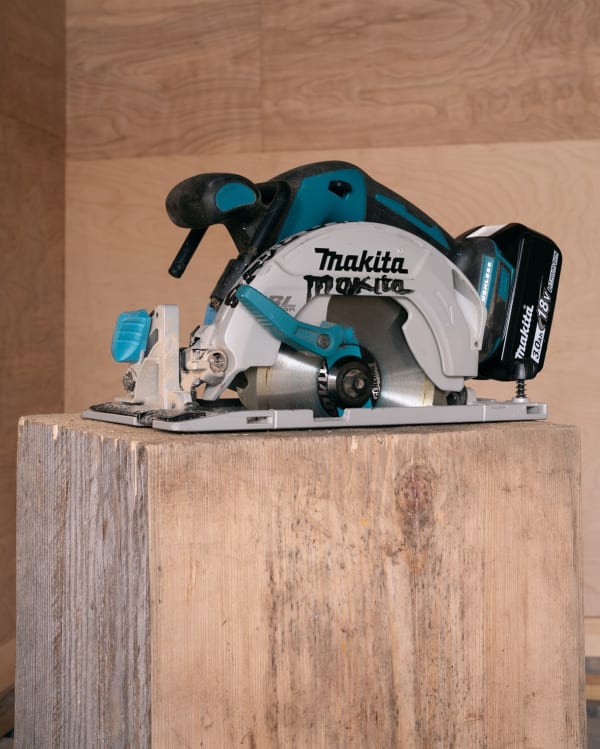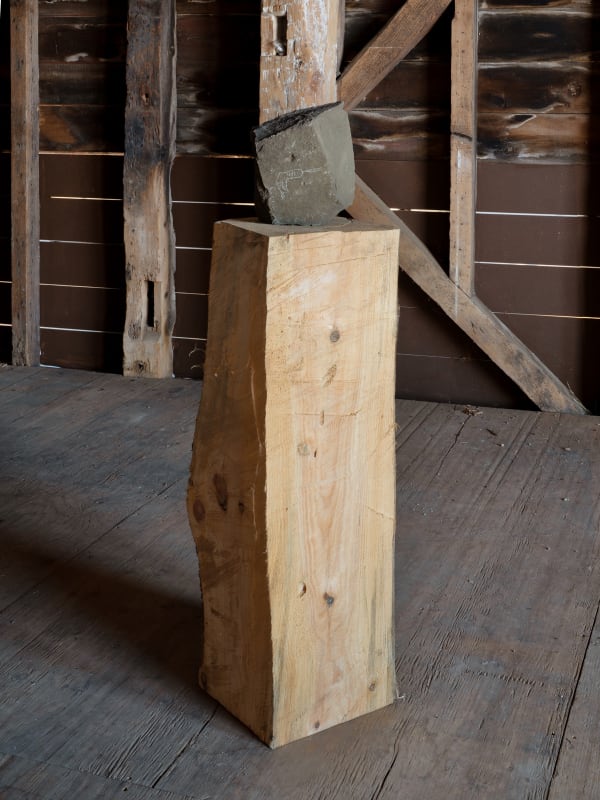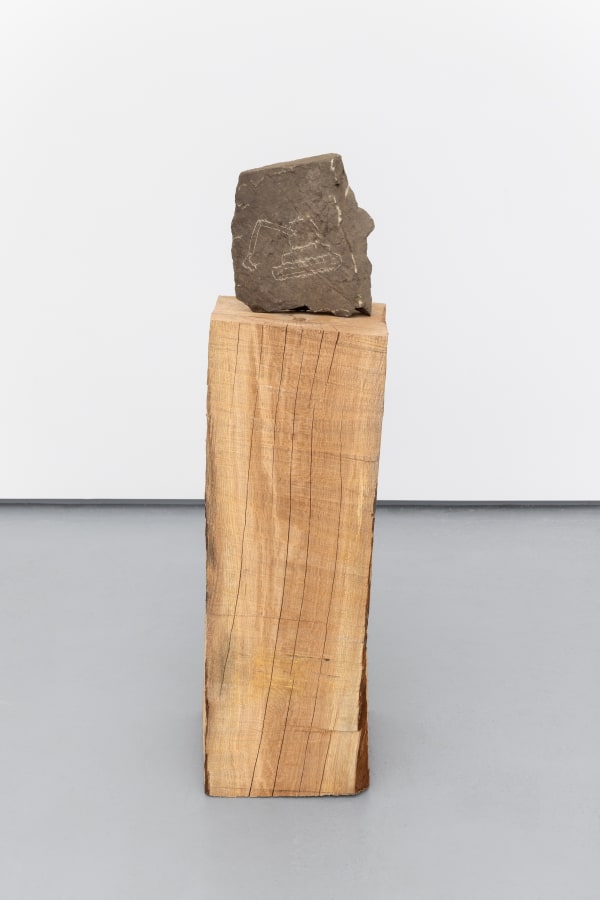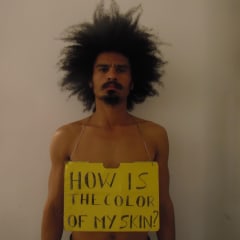Paulo Nazareth at Archipelago Paulo Nazareth
Past exhibition
Overview
Archipelago
Nov 12 – Feb 26, 2023
Archipelago is an arts-and-research institute devoted to spirituality, thinking, and healing. At a constellation of sites across the globe, we host exhibitions, artists’ residencies, and a growing research library. Our inaugural site is in Germantown, NY, overlooking the Hudson River. The first exhibition brings together works Paulo Nazareth, our first artist-in-residence.
Our site in the Hudson Valley informs much of our ethos. The river meanders between wide patches with low sloping banks and narrow, fjord-like passages constrained by sharp highlands. It famously runs in two directions, following high and low tides rushing in and out from the Atlantic.
This dramatic geological sweep was the focal point of the nineteenth-century Hudson River School. In their ethereal landscape paintings, truth-seeking and spiritual reflection were joined through a sustained engagement with nature. In response to over a century of industrialization, the valley became a major site of the new environmental movement in the 1960s. Archipelago aims to bring together a capacious approach to the arts with sustained attention towards our place in nature.
Paulo Nazareth is the inaugural artist-in-residence at Archipelago Hudson Valley. His work starts with precise and simple gestures that grow into matters of immigration, racialization, and globalization. While this work often manifests in video, photography, and found objects, his strongest medium is the cultivation of relationships with people he encounters on the road. In these journeys, Nazareth chooses to embody the romantic ideal of the wandering artist in search of himself and universal truths, unveiling assumptions about national identity, cultural history, and human value.
Nazareth’s residency in the Hudson Valley is a return to the endpoint of one of these journeys. Notícias de América / News from America (2010-12) was a three-year-long walk-performance from the artist’s home in Belo Horizonte, Brazil, to New York City. From household to household, village to village, and city to city, Nazareth elaborated a web of interpersonal connection. During the walk, he did not wash his feet, accumulating soil from each country he passed through until he arrived in New York and dipped his feet in the Hudson River. His sandaled feet were the locus of the performance, conceptually sewing the Americas back together.
Nazareth relies upon the immediacy of life itself to create an impression of the experience of being across the Americas. His approach blends notions of social justice and peaceful resistance, flowing between solemn contemplation and the light-hearted. Simple but poignant gestures are used to evoke personal and historical memory, observing social, political, and economic inequalities present throughout the Americas. In his work’s documented performances, social sculptures, drawings, and biographical portraits in video and film, he reveals a new vision of the Americas, one composed of many overlapping ways of being.
A decade after Notícias de América, Nazareth has returned to its endpoint: the Hudson River. In his months as the first Archipelago artist-in-residence, he has drawn his attention to seemingly stable elements of the local landscape: felled trees, strewn rocks, industrial walls. These elements undergo their own journeys via their encounters with Nazareth, uncovering the superficial permanence of certain aspects of nature and revealing something vibrant and tender.
Positioned at the entrance of the Barn, Nazareth placed his hallmark sandals from Notícias de América. During the years-long durational walk-performance, Nazareth did not wash his feet, collecting soil from all of the countries he passed through on this migration North from Brazil. Once arriving in New York, he washed them at last in the Hudson River.
Surrounding the sandals, Nazareth has gathered stones, carefully balanced atop hand-hewn plinths from the same forest, each plinth carved from the trunk of a single tree. The rocks are adorned with rudimentary symbols and industrial iconography of tractors and power tools, some made with charcoal and others etched into the rocks’ surface.
These are accompanied by a series of oil paintings of a nearby prison in Hudson, regularly visited by Nazareth on foot during his residency. The watchtowers and prison walls remain mute but are now reduced, turned into simple ornament.
At 10 Church Avenue, Nazareth draws on a long-running animal motif. Local tree trunks, gathered during regular walks through the autumn woods, are refigured as benches in the guise of simple silhouettes: a crocodile and a bear. As well as seating visitors, they host offerings, linking these animals, local flora, and Nazareth’s Afro-Brazilian ancestry. Sitting somewhat uneasily nearby is the circular saw that gave shape to the animals and a single wooden finger. The pelt of a roadkill racoon adorns the tree outside.
Works
-
![Paulo Nazareth, [o mata sueño _ ocean - hombre sentado en medio de la nada], 2022](data:image/gif;base64,R0lGODlhAQABAIAAAAAAAP///yH5BAEAAAAALAAAAAABAAEAAAIBRAA7) Paulo Nazareth, [o mata sueño _ ocean - hombre sentado en medio de la nada], 2022
Paulo Nazareth, [o mata sueño _ ocean - hombre sentado en medio de la nada], 2022 -
![Paulo Nazareth, [o mata sueño _ ocean - tirados al mar], 2022](data:image/gif;base64,R0lGODlhAQABAIAAAAAAAP///yH5BAEAAAAALAAAAAABAAEAAAIBRAA7) Paulo Nazareth, [o mata sueño _ ocean - tirados al mar], 2022
Paulo Nazareth, [o mata sueño _ ocean - tirados al mar], 2022 -
![Paulo Nazareth, sin titulo [yellow fear sobre fondo verde], 2022](data:image/gif;base64,R0lGODlhAQABAIAAAAAAAP///yH5BAEAAAAALAAAAAABAAEAAAIBRAA7) Paulo Nazareth, sin titulo [yellow fear sobre fondo verde], 2022
Paulo Nazareth, sin titulo [yellow fear sobre fondo verde], 2022 -
![Paulo Nazareth, sin titulo [yellow fear sobre fondo rojo], 2022](data:image/gif;base64,R0lGODlhAQABAIAAAAAAAP///yH5BAEAAAAALAAAAAABAAEAAAIBRAA7) Paulo Nazareth, sin titulo [yellow fear sobre fondo rojo], 2022
Paulo Nazareth, sin titulo [yellow fear sobre fondo rojo], 2022 -
![Paulo Nazareth, [o mata sueño _ desert - hombre camina con niña y niño], 2022](data:image/gif;base64,R0lGODlhAQABAIAAAAAAAP///yH5BAEAAAAALAAAAAABAAEAAAIBRAA7) Paulo Nazareth, [o mata sueño _ desert - hombre camina con niña y niño], 2022
Paulo Nazareth, [o mata sueño _ desert - hombre camina con niña y niño], 2022 -
![Paulo Nazareth, [o mata sueño _ desert - hombre con costalito], 2022](data:image/gif;base64,R0lGODlhAQABAIAAAAAAAP///yH5BAEAAAAALAAAAAABAAEAAAIBRAA7) Paulo Nazareth, [o mata sueño _ desert - hombre con costalito], 2022
Paulo Nazareth, [o mata sueño _ desert - hombre con costalito], 2022 -
 Paulo Nazareth, GRAN DESIERTO DE ALTAR I, 2022
Paulo Nazareth, GRAN DESIERTO DE ALTAR I, 2022 -
![Paulo Nazareth, [o mata sueño _ ocean - hombre sobre la proa], 2022](data:image/gif;base64,R0lGODlhAQABAIAAAAAAAP///yH5BAEAAAAALAAAAAABAAEAAAIBRAA7) Paulo Nazareth, [o mata sueño _ ocean - hombre sobre la proa], 2022
Paulo Nazareth, [o mata sueño _ ocean - hombre sobre la proa], 2022 -
![Paulo Nazareth, [mestre Paulo] alligator, 2022](data:image/gif;base64,R0lGODlhAQABAIAAAAAAAP///yH5BAEAAAAALAAAAAABAAEAAAIBRAA7) Paulo Nazareth, [mestre Paulo] alligator, 2022
Paulo Nazareth, [mestre Paulo] alligator, 2022 -
![Paulo Nazareth, Mestre Paulo] Bear , 2022](data:image/gif;base64,R0lGODlhAQABAIAAAAAAAP///yH5BAEAAAAALAAAAAABAAEAAAIBRAA7) Paulo Nazareth, Mestre Paulo] Bear , 2022
Paulo Nazareth, Mestre Paulo] Bear , 2022 -
 Paulo Nazareth, Maquita, 2022
Paulo Nazareth, Maquita, 2022 -
 Paulo Nazareth, Wooden finger, 2022
Paulo Nazareth, Wooden finger, 2022 -
 Paulo Nazareth, Spiritual Music, 2022
Paulo Nazareth, Spiritual Music, 2022 -
![Paulo Nazareth, mandinga [watermelon], 2022](data:image/gif;base64,R0lGODlhAQABAIAAAAAAAP///yH5BAEAAAAALAAAAAABAAEAAAIBRAA7) Paulo Nazareth, mandinga [watermelon], 2022
Paulo Nazareth, mandinga [watermelon], 2022 -
 Paulo Nazareth, kaiowa land , 2022
Paulo Nazareth, kaiowa land , 2022 -
![Paulo Nazareth, Prisons in Hudson Valley [conversion point], 2022](data:image/gif;base64,R0lGODlhAQABAIAAAAAAAP///yH5BAEAAAAALAAAAAABAAEAAAIBRAA7) Paulo Nazareth, Prisons in Hudson Valley [conversion point], 2022
Paulo Nazareth, Prisons in Hudson Valley [conversion point], 2022 -
![Paulo Nazareth, Prisons in Hudson Valley [home outside landscape], 2022](data:image/gif;base64,R0lGODlhAQABAIAAAAAAAP///yH5BAEAAAAALAAAAAABAAEAAAIBRAA7) Paulo Nazareth, Prisons in Hudson Valley [home outside landscape], 2022
Paulo Nazareth, Prisons in Hudson Valley [home outside landscape], 2022 -
![Paulo Nazareth, Prisons in Hudson Valley [diagonal; from left], 2022](data:image/gif;base64,R0lGODlhAQABAIAAAAAAAP///yH5BAEAAAAALAAAAAABAAEAAAIBRAA7) Paulo Nazareth, Prisons in Hudson Valley [diagonal; from left], 2022
Paulo Nazareth, Prisons in Hudson Valley [diagonal; from left], 2022 -
![Paulo Nazareth, Prisons in Hudson Valley [one line], 2022](data:image/gif;base64,R0lGODlhAQABAIAAAAAAAP///yH5BAEAAAAALAAAAAABAAEAAAIBRAA7) Paulo Nazareth, Prisons in Hudson Valley [one line], 2022
Paulo Nazareth, Prisons in Hudson Valley [one line], 2022 -
![Paulo Nazareth, Sem Título - [product of genocide], 2022](data:image/gif;base64,R0lGODlhAQABAIAAAAAAAP///yH5BAEAAAAALAAAAAABAAEAAAIBRAA7) Paulo Nazareth, Sem Título - [product of genocide], 2022
Paulo Nazareth, Sem Título - [product of genocide], 2022 -
![Paulo Nazareth, Prisons in Hudson Valley [diagonal line from left and from right], 2022](data:image/gif;base64,R0lGODlhAQABAIAAAAAAAP///yH5BAEAAAAALAAAAAABAAEAAAIBRAA7) Paulo Nazareth, Prisons in Hudson Valley [diagonal line from left and from right], 2022
Paulo Nazareth, Prisons in Hudson Valley [diagonal line from left and from right], 2022 -
 Paulo Nazareth, Missel , 2022
Paulo Nazareth, Missel , 2022 -
 Paulo Nazareth, Patrol tractor , 2022
Paulo Nazareth, Patrol tractor , 2022 -
 Paulo Nazareth, Drilling machine, 2022
Paulo Nazareth, Drilling machine, 2022 -
 Paulo Nazareth, Chainsaw, 2022
Paulo Nazareth, Chainsaw, 2022 -
 Paulo Nazareth, Croals, 2022
Paulo Nazareth, Croals, 2022 -
 Paulo Nazareth, Rolleytruck, 2022
Paulo Nazareth, Rolleytruck, 2022 -
 Paulo Nazareth, Submarine , 2022
Paulo Nazareth, Submarine , 2022 -
 Paulo Nazareth, Truck, 2022
Paulo Nazareth, Truck, 2022 -
 Paulo Nazareth, Trainlove, 2022
Paulo Nazareth, Trainlove, 2022 -
 Paulo Nazareth, Retro - backhoe escavator , 2022
Paulo Nazareth, Retro - backhoe escavator , 2022 -
 Paulo Nazareth, Ship , 2022
Paulo Nazareth, Ship , 2022 -
 Paulo Nazareth, Jetsky, 2022
Paulo Nazareth, Jetsky, 2022 -
 Paulo Nazareth, Sky, 2022
Paulo Nazareth, Sky, 2022 -
 Paulo Nazareth, White flag, 2022
Paulo Nazareth, White flag, 2022
Installation Views

![Paulo Nazareth, [o mata sueño _ ocean - hombre sentado en medio de la nada], 2022](https://artlogic-res.cloudinary.com/w_600,c_limit,f_auto,fl_lossy,q_auto,dpr_auto/artlogicstorage/mendeswooddm/images/view/ca975a55c61e7882d2041867c0c28aa3j/mendeswooddm-paulo-nazareth-o-mata-sue-o-_-ocean-hombre-sentado-en-medio-de-la-nada-2022.jpg)
![Paulo Nazareth, [o mata sueño _ ocean - tirados al mar], 2022](https://artlogic-res.cloudinary.com/w_600,c_limit,f_auto,fl_lossy,q_auto,dpr_auto/artlogicstorage/mendeswooddm/images/view/9301a315f9de129b57627060c11ce628j/mendeswooddm-paulo-nazareth-o-mata-sue-o-_-ocean-tirados-al-mar-2022.jpg)
![Paulo Nazareth, sin titulo [yellow fear sobre fondo verde], 2022](https://artlogic-res.cloudinary.com/w_600,c_limit,f_auto,fl_lossy,q_auto,dpr_auto/artlogicstorage/mendeswooddm/images/view/30722274dd24e6656d32c4e880f8cb80j/mendeswooddm-paulo-nazareth-sin-titulo-yellow-fear-sobre-fondo-verde-2022.jpg)
![Paulo Nazareth, sin titulo [yellow fear sobre fondo rojo], 2022](https://artlogic-res.cloudinary.com/w_600,c_limit,f_auto,fl_lossy,q_auto,dpr_auto/artlogicstorage/mendeswooddm/images/view/3ad64802a2699e753d6647450efc1f61j/mendeswooddm-paulo-nazareth-sin-titulo-yellow-fear-sobre-fondo-rojo-2022.jpg)
![Paulo Nazareth, [o mata sueño _ desert - hombre camina con niña y niño], 2022](https://artlogic-res.cloudinary.com/w_600,c_limit,f_auto,fl_lossy,q_auto,dpr_auto/artlogicstorage/mendeswooddm/images/view/4e09c88320606e3486b76ae91ea2392ej/mendeswooddm-paulo-nazareth-o-mata-sue-o-_-desert-hombre-camina-con-ni-a-y-ni-o-2022.jpg)
![Paulo Nazareth, [o mata sueño _ desert - hombre con costalito], 2022](https://artlogic-res.cloudinary.com/w_600,c_limit,f_auto,fl_lossy,q_auto,dpr_auto/artlogicstorage/mendeswooddm/images/view/ccfd5f4dc414c5639881ec01f3d444cfj/mendeswooddm-paulo-nazareth-o-mata-sue-o-_-desert-hombre-con-costalito-2022.jpg)

![Paulo Nazareth, [o mata sueño _ ocean - hombre sobre la proa], 2022](https://artlogic-res.cloudinary.com/w_600,c_limit,f_auto,fl_lossy,q_auto,dpr_auto/artlogicstorage/mendeswooddm/images/view/728b5813e3ed004d447e025fb1c37f74j/mendeswooddm-paulo-nazareth-o-mata-sue-o-_-ocean-hombre-sobre-la-proa-2022.jpg)
![Paulo Nazareth, [mestre Paulo] alligator, 2022](https://artlogic-res.cloudinary.com/w_600,c_limit,f_auto,fl_lossy,q_auto,dpr_auto/artlogicstorage/mendeswooddm/images/view/f3132fc7f42d5c71e7aa5a086bba218cj/mendeswooddm-paulo-nazareth-mestre-paulo-alligator-2022.jpg)
![Paulo Nazareth, Mestre Paulo] Bear , 2022](https://artlogic-res.cloudinary.com/w_600,c_limit,f_auto,fl_lossy,q_auto,dpr_auto/artlogicstorage/mendeswooddm/images/view/deca0c81d85cd96c2e01c75d5d46db4aj/mendeswooddm-paulo-nazareth-mestre-paulo-bear-2022.jpg)



![Paulo Nazareth, mandinga [watermelon], 2022](https://artlogic-res.cloudinary.com/w_600,c_limit,f_auto,fl_lossy,q_auto,dpr_auto/artlogicstorage/mendeswooddm/images/view/81edbb9c6de067a44e54fd623256323cj/mendeswooddm-paulo-nazareth-mandinga-watermelon-2022.jpg)

![Paulo Nazareth, Prisons in Hudson Valley [conversion point], 2022](https://artlogic-res.cloudinary.com/w_600,c_limit,f_auto,fl_lossy,q_auto,dpr_auto/artlogicstorage/mendeswooddm/images/view/a93a525b3c88b8ec2a18616432731ac8j/mendeswooddm-paulo-nazareth-prisons-in-hudson-valley-conversion-point-2022.jpg)
![Paulo Nazareth, Prisons in Hudson Valley [home outside landscape], 2022](https://artlogic-res.cloudinary.com/w_600,c_limit,f_auto,fl_lossy,q_auto,dpr_auto/artlogicstorage/mendeswooddm/images/view/a66a182a897d306788b7013fe35ab52dj/mendeswooddm-paulo-nazareth-prisons-in-hudson-valley-home-outside-landscape-2022.jpg)
![Paulo Nazareth, Prisons in Hudson Valley [diagonal; from left], 2022](https://artlogic-res.cloudinary.com/w_600,c_limit,f_auto,fl_lossy,q_auto,dpr_auto/artlogicstorage/mendeswooddm/images/view/76e95ec8a6d5a1874409e8fa200e25fej/mendeswooddm-paulo-nazareth-prisons-in-hudson-valley-diagonal-from-left-2022.jpg)
![Paulo Nazareth, Prisons in Hudson Valley [one line], 2022](https://artlogic-res.cloudinary.com/w_600,c_limit,f_auto,fl_lossy,q_auto,dpr_auto/artlogicstorage/mendeswooddm/images/view/704a53c3d3bea5402d5a140a5d0e8b00j/mendeswooddm-paulo-nazareth-prisons-in-hudson-valley-one-line-2022.jpg)
![Paulo Nazareth, Sem Título - [product of genocide], 2022](https://artlogic-res.cloudinary.com/w_600,c_limit,f_auto,fl_lossy,q_auto,dpr_auto/artlogicstorage/mendeswooddm/images/view/a6e06492203d8b75c68cdfa531e7b0aaj/mendeswooddm-paulo-nazareth-sem-t-tulo-product-of-genocide-2022.jpg)
![Paulo Nazareth, Prisons in Hudson Valley [diagonal line from left and from right], 2022](https://artlogic-res.cloudinary.com/w_600,c_limit,f_auto,fl_lossy,q_auto,dpr_auto/artlogicstorage/mendeswooddm/images/view/fbb0741aa0a69288fd8834153846faecj/mendeswooddm-paulo-nazareth-prisons-in-hudson-valley-diagonal-line-from-left-and-from-right-2022.jpg)















